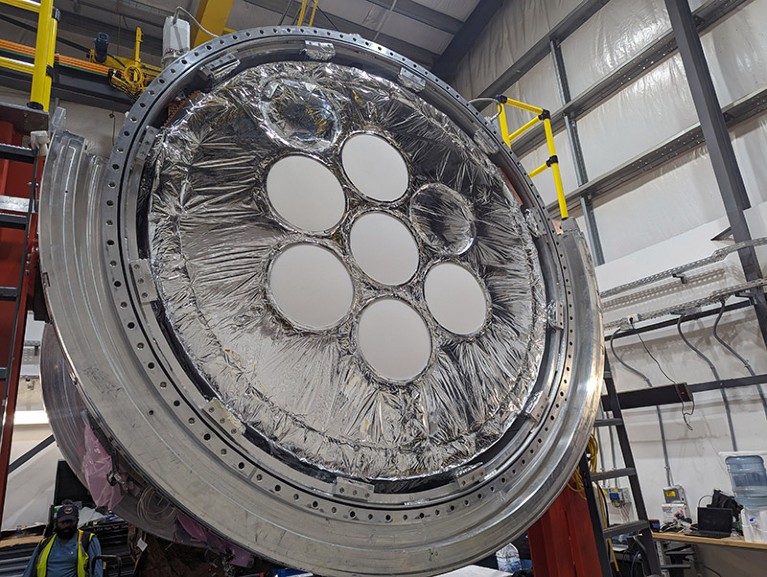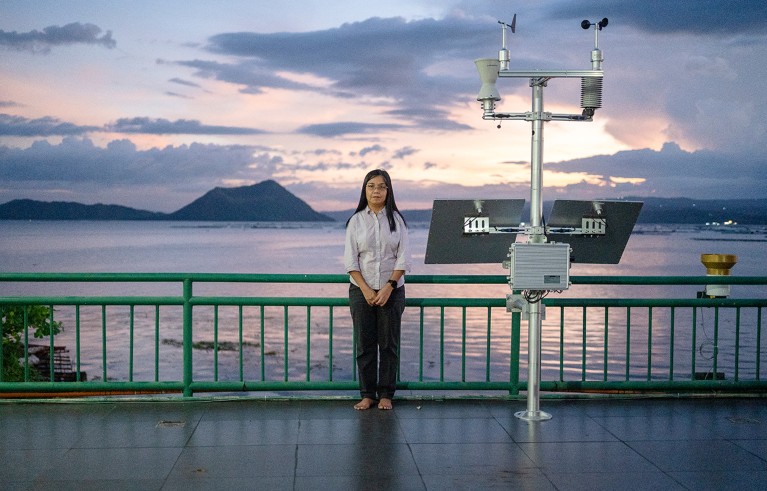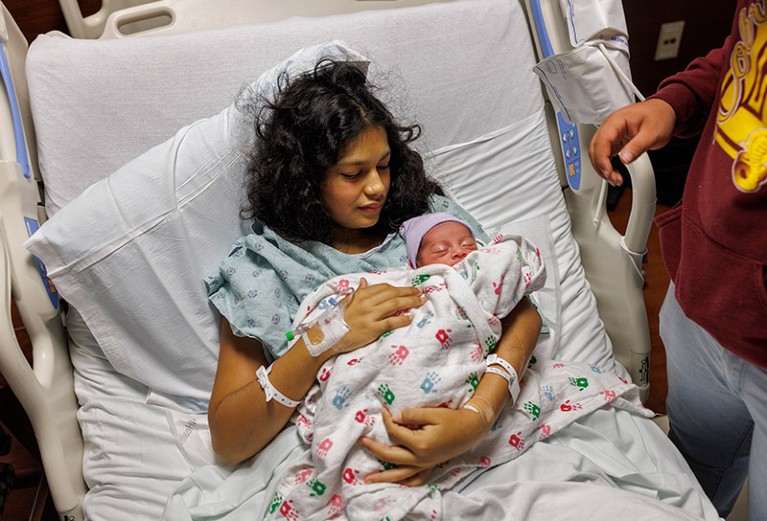[ad_1]
Hello Nature readers, would you like to get this Briefing in your inbox free every day? Sign up here.

The front of the Simons Observatory’s Large Aperture Telescope Receiver, the largest receiver for observing the cosmic microwave background built so far.Credit: Mark Devlin/University of Pennsylvania
In a few weeks, a new observatory high in northern Chile’s Atacama Desert will be ready to map the cosmic microwave background (CMB) with unprecedented sensitivity. One of the goals of the Simons Observatory is to find fingerprints left in the CMB by gravitational waves that originated from the Big Bang itself. These would provide incontrovertible evidence for cosmic inflation, a brief moment when the expansion of the early universe is thought to have accelerated hugely. There is no guarantee that the inflation signature, if it exists, is strong enough for the Simons Observatory to detect, says cosmologist Suzanne Staggs, who is the observatory’s co-director. “But oh my gosh — if they were right there, it would be amazing.”
A 62-year-old man with end-stage renal failure has become the first living person to receive a pig kidney transplant. The kidney was taken from a miniature pig carrying a record 69 genomic edits, which were aimed at preventing rejection of the donated organ and reducing the risk that a virus lurking in the organ could infect the recipient. So far, the patient is recovering well and the pig kidney is producing urine and showing other signs of a working organ. This early success has raised researchers’ hopes for larger clinical trials involving pig organs. It follows from news last week that surgeons say they have transplanted a genetically modified pig liver into a person for the first time.
Studies in mice and humans suggest that being pregnant can increase a person’s ‘biological age’ by a couple of years — but giving birth reverses these changes. Biological age can be estimated from patterns of DNA methylation, which occurs when chemical methyl groups are added to DNA. The patterns reflect the stresses that a body accrues over time. The work supports the idea that “biological age is quite flexible; it’s a fluid parameter. It can go up and down”, says biomedical scientist Vadim Gladyshev.
Reference: Cell Metabolism paper
China has launched a spacecraft to the Moon that will act as a communications link between Earth and the lunar far side.Queqiao-2, named after a folktale in which magpies form a bridge across the sky, will support China’s Chang’e-6 mission, set to launch in May. Chang’e-6 aims to become the first mission to collect samples from the far side of the Moon, which is permanently hidden from Earth. Queqiao-2 will also support future Chinese missions to the lunar south pole and will take over from its predecessor, Queqiao-1.
Read more on Queqiao-1: Chinese satellite launch kicks off ambitious mission to Moon’s far side (Nature | 4 min read, Nature paywall)
Features & opinion
There is a type of test for infections such as COVID-19 that is almost as accurate as a polymerase chain reaction (PCR) test — which has to be done by a laboratory — and as easy and quick as the rapid antigen tests many of us have used at home. They are ‘isothermal tests’ — so-called because they operate at a consistent temperature, eliminating the need for the repetitive heating and cooling cycles of PCR. They’re comparatively expensive and have stumbled over bureaucratic hurdles. Still, developers are pushing forward, targeting applications such as at-home testing for sexually transmitted infections.
This article is part of the editorially independent supplement Nature Outlook: Medical diagnostics, produced with financial support from Seegene.
A study that looked at home-grown food and community gardens in the United States and Europe unveiled a surprising conclusion: the carbon footprint of food from urban agriculture is six times greater than the conventional, commercial version. Allotmenteers recoiled from the result, but the authors — keen home-growers themselves — emphasize that their findings can help make urban efforts (which have worthwhile social benefits) more carbon-efficient. Upcycling refuse as infrastructure such as raised beds, using equipment for a long time, collecting rainwater for irrigation and practising optimal composting can all help. And for some carbon-intensive commercial products, such as tomatoes, growing locally is already on par with big farms.
Reference: Nature Cities paper
Peggy Oti-Boateng, a Ghanaian biochemist, and Lise Korsten, a South African food-security researcher, are at the helm of the African Academy of Sciences at a critical time. They have a new strategic plan, with five areas of focus, and a desire to recruit scientists in the African diaspora as members. “We have lost a group of young academics who should have now been leaders on the continent, the professors of the future — and maybe we can partially bring them back,” says Korsten, the academy’s first female president.
Where I work

Mariton Antonia Bornas is chief of the Volcano Monitoring and Eruption Prediction Division of PHIVOLCS in Quezon City.Credit: Dave Tacon for Nature
“We have a lot of natural disasters in the Philippines,” says Mariton Antonia Bornas, pictured here standing next to a monitoring station overlooking Taal volcano, which erupted in January 2020. As chief of the Volcano Monitoring and Eruption Prediction Division, her job is to provide early warning of potential eruptions and to monitor levels of harmful emissions. The hardest part of the job is “dealing with the non-science,” she says. “Responding to people online — even to psychics predicting an eruption — is part of my job and it doubles my work. I have to be a communicator, not just a scientist.” (Nature | 2 min read)
Last week in our penguin-search puzzle, Leif Penguinson was enjoying the river landscape of Oulanka National Park in Finland. Did you find the penguin? When you are ready, here’s the answer.
Thanks for reading,
Flora Graham, senior editor, Nature Briefing
With contributions by Katrina Krämer, Smriti Mallapaty and Sarah Tomlin
Want more? Sign up to our other free Nature Briefing newsletters:
• Nature Briefing: Anthropocene — climate change, biodiversity, sustainability and geoengineering
• Nature Briefing: AI & Robotics — 100% written by humans, of course
• Nature Briefing: Cancer — a weekly newsletter written with cancer researchers in mind
• Nature Briefing: Translational Research covers biotechnology, drug discovery and pharma
[ad_2]
Source Article Link





